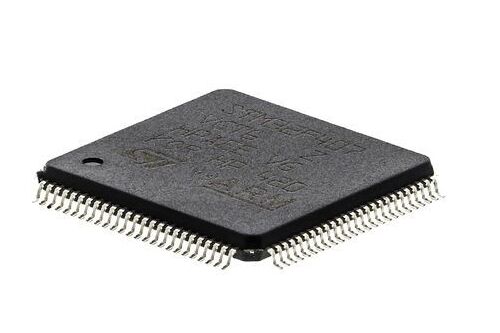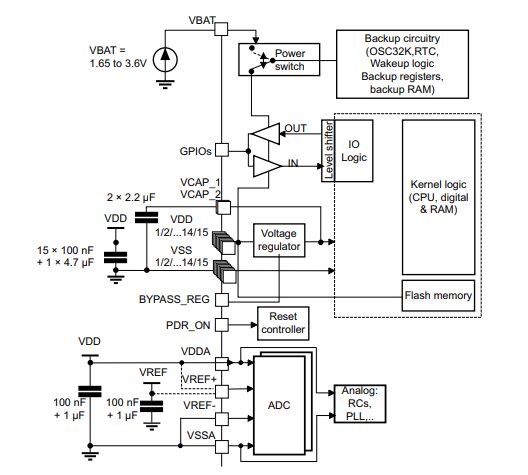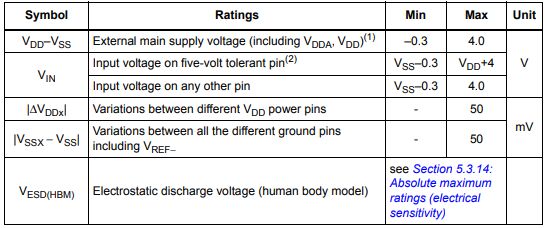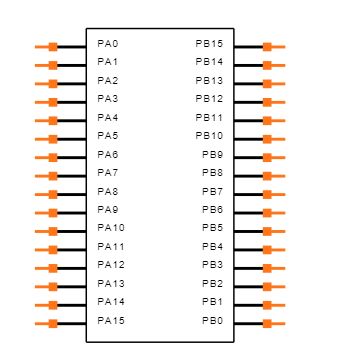By STMicroelectronics 158
STM32F407VGT6 is a 32-bit MCU microcontroller, based on the high-performance Arm® Cortex®-M4 32-bit RISC core, operating frequency up to 168 MHz, with floating point unit (FPU) single precision, and supports all Arm single-precision data processing instructions and data types . It also implements a full set of DSP instructions and a Memory Protection Unit (MPU) for enhanced application security.
The STM32F407VGT6 contains high-speed embedded memory (up to 1 Mbyte of Flash and up to 192 Mbyte of SRAM), up to 4 Mbyte of backup SRAM, and connectivity to two APB buses, three AHB buses, and a 32-bit multi-AHB bus matrix. A host of enhanced I/O and peripherals.

Ⅰ.Specifications of STM32F407VGT6
•Product Category:ARM Microcontroller-MCU
•Installation style:SMD/SMT
•Package/Case:LQFP-100
•Program memory size:1 MB
•Data bus width:32 bit
•ADC resolution:12 bit
•Maximum clock frequency:168 MHz
•Number of input/output terminals:82 I/O
•Data RAM size:192 kB
•Supply voltage-Minimum:1.8 V
•Supply voltage-Max:3.6 V
•Minimum operating temperature:-40℃
•Maximum operating temperature:+85℃
•DAC resolution:12 bit
•Data Ram type:SRAM
•Interface type:CAN, I2C, SDIO, I2S/SPI, UART/USART, USB
•Humidity Sensitivity:Yes
•Number of ADC channels:16 Channel
•Processor series:STM32F40
•Product type:ARM Microcontrollers - MCU
•Number of digits:32
•Digital-to-analog conversion number(DAC):1
•Number of pins:100
•Length:14.2 mm
•Width:14.2 mm
•Height:1.45 mm
•Program memory type:flash memory
•Data converter:A/D 16x12b; D/A 2x12b
Ⅱ.Characteristics of STM32F407VGT6
•LCD parallel interface, 8080/6800 modes
•Memories
-Up to 1 Mbyte of Flash memory
-512 bytes of OTP memory
-Up to 192+4 Kbytes of SRAM including 64-Kbyte of CCM (core coupled memory) data RAM
-Flexible static memory controller supporting Compact Flash, SRAM, PSRAM,NOR and NAND memories
•Low-power operation
-Sleep, Stop and Standby modes
-VBAT supply for RTC, 20×32 bit backup registers + optional 4 KB backup SRAM
•Clock, reset and supply management
-POR, PDR, PVD and BOR
-1.8V to 3.6V application supply and I/Os
-Internal 32 kHz RC with calibration
-32 kHz oscillator for RTC with calibration
-Internal 16 MHz factory-trimmed RC (1% accuracy)
-4-to-26 MHz crystal oscillator
•Advanced connectivity
-USB 2.0 full-speed device/host/OTG controller with on-chip PHY
-USB 2.0 high-speed/full-speed device/host/OTG controller with dedicated DMA, on-chip full-speed PHY and ULPI
•High performance: STM32F407VGT6 uses a high-speed ARM Cortex-M4 core with a floating-point unit and DSP instruction set to achieve high-performance digital signal processing and algorithmic operations.
•Low power consumption: STM32F407VGT6 adopts a low power consumption design and can work in multiple modes, such as normal mode, low power consumption mode and standby mode, to achieve energy saving and emission reduction.
•High-speed data transmission: STM32F407VGT6 has high-speed FSMC interface, SDIO interface, USB OTG and Ethernet interface, supporting high-speed data transmission and processing.
•Large-capacity storage: STM32F407VGT6 has built-in flash memory of up to 1MB and 192KB of SRAM, which can be used to store program code and data cache.
•Good ecosystem: STM32F407VGT6 is a product of STMicroelectronics. The company has a complete ecosystem of development tools, chip parameters, technical documentation and community resources to help developers quickly develop and optimize products.
Ⅲ.Power supply scheme of STM32F407VGT6

Ⅳ.Absolute maximum ratings of STM32F407VGT6

Ⅴ.Application fields of STM32F407VGT6
1.Automotive electronics: In automotive electronic systems, the main function of STM32F407VGT6 is to realize the collection, processing and control of various sensor data, as well as to communicate and interact with other automotive electronic devices. For example, in the engine control unit (ECU), STM32F407VGT6 can collect various sensor data of the engine, such as temperature, pressure, speed, etc., and calculate and control the engine's ignition time, fuel injection amount, valve opening and other parameters based on these data , to improve engine performance and fuel economy.
2.Medical equipment: Due to its high performance and reliability, STM32F407VGT6 is often used in medical equipment, such as medical image processing, vital sign monitoring and medical instrument control.
•Medical image processing: In the medical field, image processing is a very important link. For example, CT, MRI and other types of medical images need to be processed quickly and accurately. The powerful processing capabilities of the STM32F407VGT6 enable it to quickly process these complex image data and help doctors diagnose the condition more accurately.
•Medical instrument control: In the operating room or other medical environment, precise control of medical instruments is crucial. STM32F407VGT6 can accurately control and monitor various medical equipment, such as ventilators, infusion pumps, etc., to ensure that they work according to preset parameters and provide safe and effective medical services to patients.
•Vital sign monitoring: In patient vital sign monitoring, equipment is required that can collect and process physiological data accurately in real time. STM32F407VGT6 can process data from various sensors, such as electrocardiogram, blood pressure, blood oxygen saturation, etc., and analyze these data through algorithms to provide timely and accurate information to medical staff.
•Medical electronic device integration: In many advanced medical devices, various subsystems need to be integrated together. With its rich peripheral interfaces, STM32F407VGT6 can easily communicate and control with other medical electronic equipment to achieve integration and collaborative work of the entire medical equipment.
•Telemedicine: With the development of telemedicine technology, many medical devices need to have remote communication and control functions. STM32F407VGT6 can connect medical equipment to the Internet or LAN through WiFi, Bluetooth or other communication technologies to achieve remote data transmission and control.
3.Communication equipment: STM32F407VGT6 can be found in communication equipment, used to control and process communication modules, such as Wi-Fi modules, Bluetooth modules, etc.
•Wi-Fi module: STM32F407VGT6 can handle the large amount of data sent by the Wi-Fi module to ensure a smooth, delay-free network connection.
•Routers and switches: The high performance of STM32F407VGT6 enables it to be used as the main control chip of routers or switches for rapid processing and forwarding of data packets.
•Bluetooth module: For Bluetooth devices that require low power consumption and stable data transmission, STM32F407VGT6 is a good choice.
•Modem: In communication, modem is an essential part. STM32F407VGT6 can handle the modulation and demodulation process to ensure stable transmission of signals.
4.Industrial automation: STM32F407VGT6 is widely used in industrial control systems, such as PLC (programmable logic controller), sensor control, motion control, etc.
•PLC (Programmable Logic Controller): The high performance and rich peripheral interfaces of STM32F407VGT6 make it an ideal choice for PLC. It can handle complex logic and control algorithms to ensure the stable operation of industrial equipment.
•Motion control: In manufacturing and processing processes, precise control of machine movement is crucial. STM32F407VGT6 can control servo motors or other types of actuators through PWM signals to achieve high-precision motion control.
•Sensor control: In industrial automation, sensors are the key to obtaining equipment status and environmental information. STM32F407VGT6 can receive and process data from various sensors, such as temperature, pressure, flow, etc., and make corresponding control decisions based on these data.
•Process Control: In chemical, pharmaceutical and other process industries, precise control of various process parameters is key. STM32F407VGT6 can receive data from various sensors and adjust the status of various valves, pumps and other equipment through PID algorithms or other control algorithms to ensure the stability and efficiency of the process.
•Remote monitoring and control: In many modern industrial automation systems, remote monitoring and control have become an important requirement. STM32F407VGT6 can communicate with the host computer or cloud platform through WiFi, Ethernet or other communication technologies, allowing engineers and operators to remotely monitor the status and performance of the equipment, as well as perform remote control.
5.Military and aerospace applications: The high performance and reliability of STM32F407VGT6 have found applications in the military and aerospace fields for control, navigation and communication systems.
•Control and navigation systems: In the military and aerospace fields, precise control and navigation are crucial. The high performance and reliability of the STM32F407VGT6 make it ideal for these systems, capable of processing navigation, control and communication data quickly and accurately.
•Sensor data processing: In these fields, various sensors are used to obtain environmental data. The STM32F407VGT6 can quickly process this data and perform real-time analysis through algorithms to provide key information to decision makers.
•Communication systems: In the military and aerospace fields, communication systems need to have a high degree of reliability and security. STM32F407VGT6 can handle complex communication protocols to ensure the accuracy and real-time nature of data transmission.
•High-speed data transmission: High-speed transmission of large amounts of data is often required in the military and aerospace fields. STM32F407VGT6 has high-speed FSMC interface, SDIO interface, USB OTG and Ethernet interface to meet these needs.
•Reliability: In these critical areas, equipment reliability is critical. The STM32F407VGT6 has undergone strict quality control and reliability testing to meet these high standards.
6.Consumer electronics: STM32F407VGT6 is also widely used in consumer electronics products, such as smart home devices, audio processors, digital cameras and embedded systems.
•Smart home devices: Smart home devices need to have high performance, low power consumption and easy programming. STM32F407VGT6 can meet various smart home functions such as remote control, voice recognition and environmental monitoring.
•Digital Cameras: Modern digital cameras require complex image processing and real-time video streaming. The high-performance image processing capabilities of the STM32F407VGT6 can improve camera performance and shooting quality.
•Audio processor: For consumer electronics products that require high-quality audio processing, such as wireless headphones, speakers, and recording equipment, the STM32F407VGT6's high-performance digital signal processing capabilities make it an ideal choice.
•Game consoles and gaming peripherals: Game consoles and peripherals require high-speed data processing capabilities and low-latency response. The high performance of STM32F407VGT6 ensures a smooth gaming experience.
•Embedded systems: In many consumer electronics products, such as TV remote controls, printers and smart watches, STM32F407VGT6 can be used as the main controller to realize various functions and control of the device.
Ⅵ.Steps to download the program to the STM32F407VGT6 microcontroller
1.Choose a development environment: Choose a suitable development environment. Common development environments include Keil, IAR, STM32CubeIDE, etc. These integrated development environments typically provide rich development tools and debugging capabilities. ,
2.Write or generate programs: Use the selected development environment to write your embedded program, or generate initialization code through tools such as STM32CubeMX.
3.Connect the development board: Plug the STM32F407VGT6 microcontroller into your development board. Make sure the connections are correct, including clock, power, and debug interface (such as JTAG or SWD).
4.Configure debugging/programming tools: If using a debugging tool (such as ST-Link or J-Link), make sure it is properly connected to the development board's debugging interface. If you use a serial interface (such as UART, USB, etc.) for programming, configure the corresponding tools.
5.Select the download method: Select the download method, you can download through the debugging interface (such as ST-Link, J-Link) or other supported download methods (such as serial port, USB DFU mode).
6.Set the target chip: Set the target chip to STM32F407VGT6 in the development environment, and ensure that the chip configuration used matches the target chip.
7.Compile: Compile your program in the development environment. Make sure there are no compilation errors.
8.Download the program: Use the selected download tool to download the compiled program to the STM32F407VGT6 microcontroller. This can be done by clicking the "Download" button, using a command line tool, or another download method.
9.Debugging: You can use debugging tools for debugging. Set breakpoints and view the values of registers and variables in the development environment to ensure your program is running properly.
10.Verify: Make sure the program is successfully downloaded into the STM32F407VGT6 microcontroller and works as expected. You can use serial port output, LED indicators, or other debugging methods for verification.
Ⅶ.Pin diagram of STM32F407VGT6

Ⅷ.Embedded reset and power control block characteristics of STM32F407VGT6

Ⅸ.How to configure the clock of STM32F407VGT6?
1.Select clock source: Select the clock source of the main clock. STM32F407VGT6 supports multiple clock sources, including internal RC oscillator, external crystal oscillator, external clock source, etc. Through the configuration register, select the clock source suitable for the application.
2.Configure PLL (Phase Locked Loop): If you need to increase the clock frequency, you can enable the PLL and configure the corresponding frequency multiplication factor. A PLL is a circuit used to generate a high-frequency clock that increases the input clock frequency to a higher multiplier.
3.Configure the divider: Configure the main clock divider to obtain the required system clock frequency. The main clock frequency will affect the performance of the entire system, including CPU clock, bus clock, etc.
4.Configure AHB, APB1 and APB2 dividers: STM32F407VGT6 has multiple buses, such as AHB, APB1 and APB2. The clock frequency of these buses is configurable through the corresponding dividers.
5.Enable external clock source: If you use an external crystal oscillator or other external clock source, you need to enable the corresponding configuration.
6.Configure the Flash wait state: Changes in the main clock frequency may affect the access speed of the Flash memory, so the Flash wait state needs to be configured to ensure the correct read speed.
Frequently Asked Questions
1.What is the power consumption of STM32F407VGT6?
The power consumption performance of STM32F407VGT6 is related to its working mode and operating frequency. In standby mode, its power consumption is 3.3V@500uA, while in working mode, its power consumption is 3.3V@5mA. In high-performance mode, its power consumption is 178mA, and in low-power mode, its power consumption is 22mA.
2.How does the STM32F407VGT6 handle power management and low-power modes?
The STM32F407VGT6 includes power management features and supports low-power modes to optimize energy consumption. It provides options for configuring and transitioning between different power modes based on application requirements.
3.Can you describe the memory architecture of the STM32F407VGT6, including Flash and RAM specifications?
The STM32F407VGT6 typically has a Flash memory size of up to 1 MB for program storage and varying amounts of SRAM (Static Random Access Memory) for data storage, which can range from 192 KB to 196 KB depending on the specific variant.